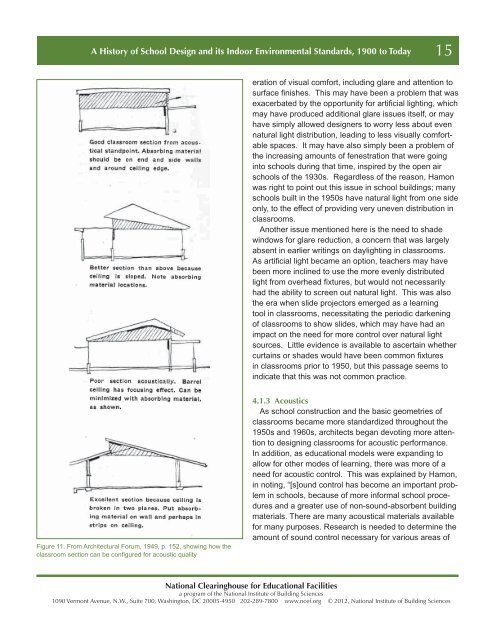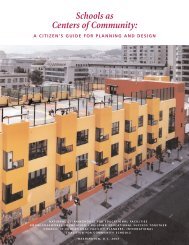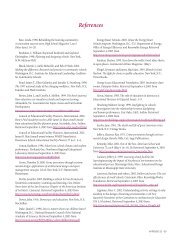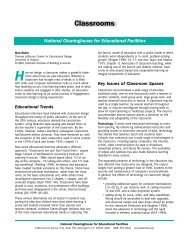A History of School Design and its Indoor - National Clearinghouse ...
A History of School Design and its Indoor - National Clearinghouse ...
A History of School Design and its Indoor - National Clearinghouse ...
Create successful ePaper yourself
Turn your PDF publications into a flip-book with our unique Google optimized e-Paper software.
A <strong>History</strong> <strong>of</strong> <strong>School</strong> <strong>Design</strong> <strong>and</strong> <strong>its</strong> <strong>Indoor</strong> Environmental St<strong>and</strong>ards, 1900 to Today<br />
Figure 11. From Architectural Forum, 1949, p. 152, showing how the<br />
classroom section can be confi gured for acoustic quality<br />
<strong>National</strong> <strong>Clearinghouse</strong> for Educational Facilities<br />
a program <strong>of</strong> the <strong>National</strong> Institute <strong>of</strong> Building Sciences<br />
1090 Vermont Avenue, N.W., Suite 700, Washington, DC 20005-4950 202-289-7800 www.ncef.org © 2012, <strong>National</strong> Institute <strong>of</strong> Building Sciences<br />
15<br />
eration <strong>of</strong> visual comfort, including glare <strong>and</strong> attention to<br />
surface fi nishes. This may have been a problem that was<br />
exacerbated by the opportunity for artifi cial lighting, which<br />
may have produced additional glare issues <strong>its</strong>elf, or may<br />
have simply allowed designers to worry less about even<br />
natural light distribution, leading to less visually comfortable<br />
spaces. It may have also simply been a problem <strong>of</strong><br />
the increasing amounts <strong>of</strong> fenestration that were going<br />
into schools during that time, inspired by the open air<br />
schools <strong>of</strong> the 1930s. Regardless <strong>of</strong> the reason, Hamon<br />
was right to point out this issue in school buildings; many<br />
schools built in the 1950s have natural light from one side<br />
only, to the effect <strong>of</strong> providing very uneven distribution in<br />
classrooms.<br />
Another issue mentioned here is the need to shade<br />
windows for glare reduction, a concern that was largely<br />
absent in earlier writings on daylighting in classrooms.<br />
As artifi cial light became an option, teachers may have<br />
been more inclined to use the more evenly distributed<br />
light from overhead fi xtures, but would not necessarily<br />
had the ability to screen out natural light. This was also<br />
the era when slide projectors emerged as a learning<br />
tool in classrooms, necessitating the periodic darkening<br />
<strong>of</strong> classrooms to show slides, which may have had an<br />
impact on the need for more control over natural light<br />
sources. Little evidence is available to ascertain whether<br />
curtains or shades would have been common fi xtures<br />
in classrooms prior to 1950, but this passage seems to<br />
indicate that this was not common practice.<br />
4.1.3 Acoustics<br />
As school construction <strong>and</strong> the basic geometries <strong>of</strong><br />
classrooms became more st<strong>and</strong>ardized throughout the<br />
1950s <strong>and</strong> 1960s, architects began devoting more attention<br />
to designing classrooms for acoustic performance.<br />
In addition, as educational models were exp<strong>and</strong>ing to<br />
allow for other modes <strong>of</strong> learning, there was more <strong>of</strong> a<br />
need for acoustic control. This was explained by Hamon,<br />
in noting, “[s]ound control has become an important problem<br />
in schools, because <strong>of</strong> more informal school procedures<br />
<strong>and</strong> a greater use <strong>of</strong> non-sound-absorbent building<br />
materials. There are many acoustical materials available<br />
for many purposes. Research is needed to determine the<br />
amount <strong>of</strong> sound control necessary for various areas <strong>of</strong>










